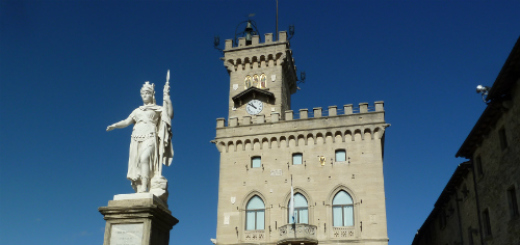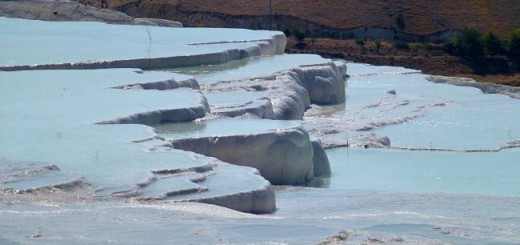Barcelona to the Costa Brava
Our HAL cruise on the Rotterdam finished in Barcelona, arriving in the afternoon, but allowing us one more night aboard the ship before an early morning departure. This gave us one last opportunity to explore a few more places there that we might have missed during our week’s stay before the cruise. The port is a vast space and you need a shuttle bus or taxi to take you into the city. The shuttle was fine for us that afternoon, but we made sure to take a taxi after disembarking the next morning as the port area was very congested.
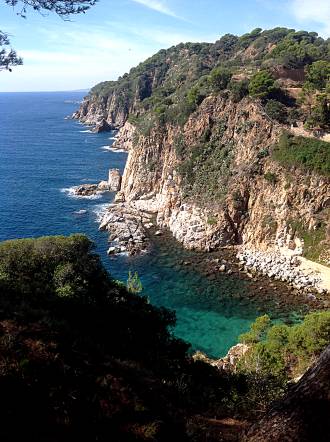
We had booked with BCN Tours for a half-day tour of the Costa Brava as one last place to explore in our holiday before our evening flight home. We were to meet the tour bus at Plaça Catalunya and luckily for us, we were able to bring our bags along with us, solving the problem of what to do with our luggage while we were sightseeing.
The Costa Brava is the coastal region north of Barcelona, which extends as far as the French border. It is so called because of its wild coastline – rugged promontories, rough vegetation and rocky cliffs. Tourism has been its major source of income due to the good summer climate, natural beauty and excellent beaches. Our first stop was at the town of Lloret de Mar, about an hour north of Barcelona, which is the biggest of the coast’s beach resorts, with an exceptionally long wide beach.
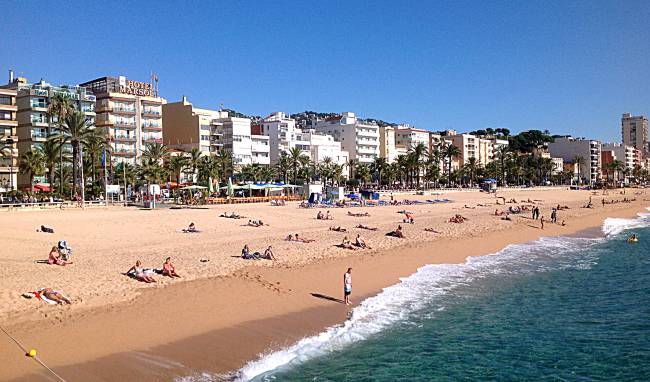

We had time to wander around the town, admiring the older architecture and shops set back behind an esplanade that was packed with cafes, fast food outlets, holiday apartments and hotels. One amazing site was the parish church of Sant Romà, built in Catalan Gothic style, between 1509 and 1522.
The two side chapels, El Baptisteri and El Santíssim Sagrament Chapel are in Modernista style, constructed in 1916, displaying beautiful mosaic decorations. In stark contrast, the façade of the casino uphill from the town was the height of 21st century architecture.
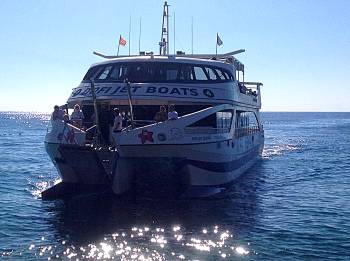
Back on the beach we were met by the jet boat Neptune, which was to take us on a short cruise further up the coast. Here we could see first hand the ruggedness of the coast.

One interesting sight was the Castell d’en Plaja, the former home of a wealthy industrialist, which appeared as a medieval castle on the cliffs, but was in fact constructed between 1935 and 1940.
Midway to our intended destination, the boat drew in close to a gap between two promontories to allow the passengers to get a glimpse of the local fish. The boat had a glass bottom viewing area and the fish were treated with scraps to encourage them to come alongside.

The first sight of Tossa de Mar, another of the coast’s popular resort towns, was of the towers and ramparts of the Vila Vella or old town. Beyond the point the “new” town, comprised of a large number of white buildings, stood out blindingly in the sunlight.

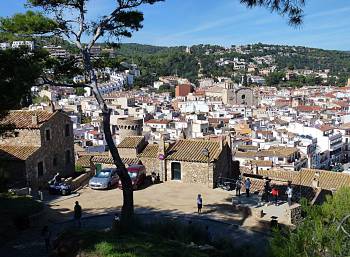
Vila Vella is the sole remaining fortified medieval town on the Catalan coast and was listed as an artistic-historic monument in 1931. The original structure dates from the 13th-century. On the day of our visit there was a medieval fair in progress, with food tents and displays set up along the road that led to the old town entrance. At its height, there were about eighty houses within the wall, but by the 16th century population growth forced the establishment of a town outside the walls.

Inside the Vila Vella there also are the remains of the late-Gothic 15th-century church of Sant Vicenç. With the expansion of the town, a new church of Sant Vicenç needed to be built, so the Gothic church fell into disuse. Today, the only remaining covered parts are the apse and the sacristy. Through its arched windows panoramic views of Tossa de Mar could be seen. Further along the narrow alleyways we walked up to the lighthouse where we saw more spectacular views of the rugged Costa Brava.

After all that climbing and walking we headed down to the esplanade where restaurants provided a welcome stop for a tapas style lunch. Then it was time for some more wandering the streets of Tossa and a quick look at the ruins of the Roman villa of Ametllers, before meeting our bus for the one and a half hour trip back to Barcelona. It might have been billed as a half-day tour, but it was a very long half-day! Needless to say, there were quite a few sleepy heads in the bus on the way back.
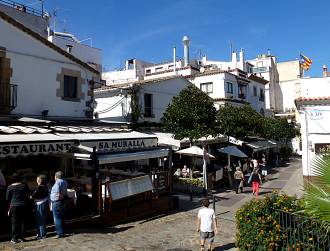
Of course our day did not end there – we had to catch the Aerobus in Plaça Catalunya to take us to El Prat airport for an evening flight. There we had a 5 hour wait! So we used our Priority Passes to go into the Miró VIP lounge and helped ourselves to snacks and Codorniú cava, even managing a little siesta in the ‘sleep room’ before our flight was called. We had reached the end of our five weeks of holidays and were glad to be heading back to Melbourne to see our family again. The desire to explore the world was sated for the time being, but there will be many more adventures to come.
Related articles
- Costa Brava travel guide (telegraph.co.uk)
- Cheapest Travel Packages (economicnewsarticles.org)
- Visit beautiful Lloret De Mar in Spain for spending vacations (glasby-sam.blogspot.com)





